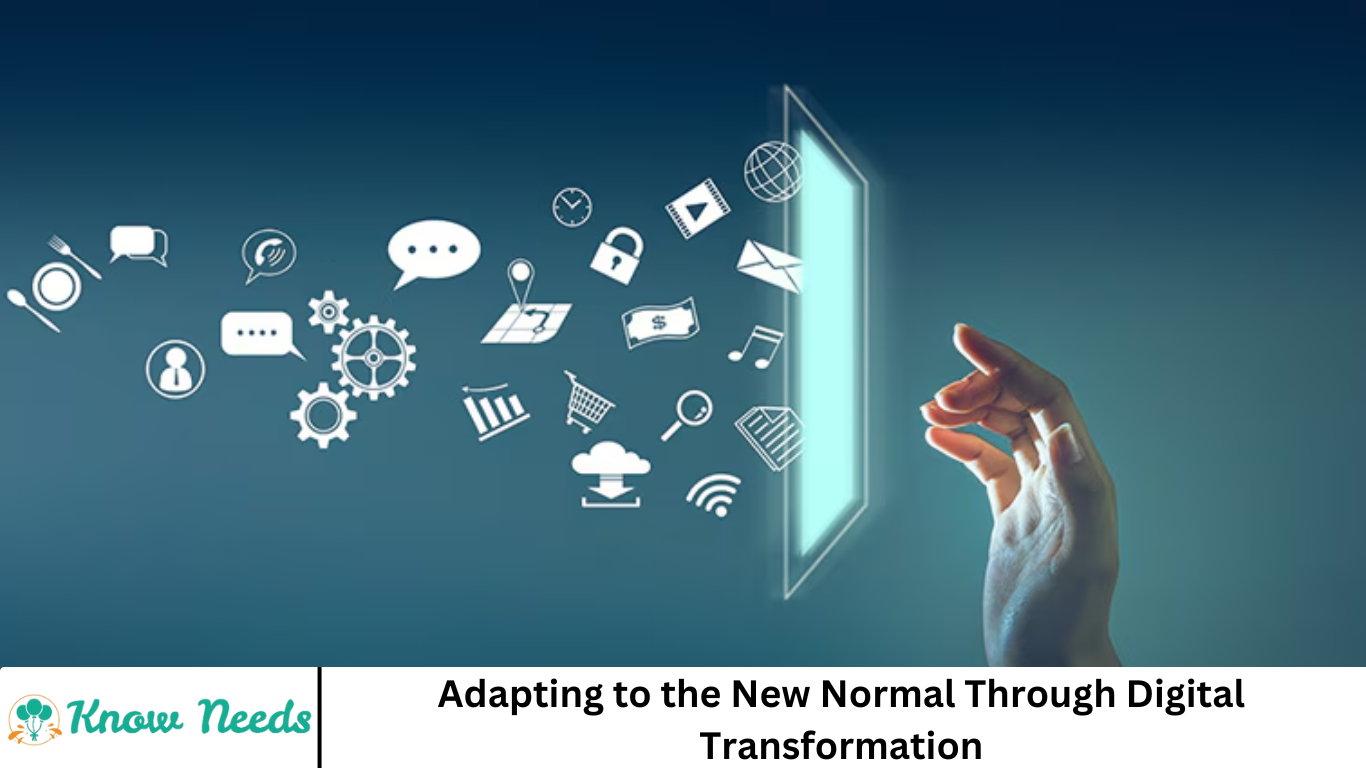The world as we knew it changed drastically with the onset of the COVID-19 pandemic. Businesses, educational institutions, healthcare providers, and individuals were forced to rethink how they operate, communicate, and deliver value.
This dramatic shift accelerated the adoption of digital technologies, leading to what many call the “new normal.” At the heart of this transformation lies digital transformation — a strategic adoption of digital tools and processes that enable organizations and individuals to adapt, survive, and thrive in the new environment.
We will explore how digital transformation has become essential in adapting to the new normal across various sectors, the challenges faced, and the future outlook. Whether you’re a business leader, educator, healthcare professional, or simply curious about the digital shift, this guide will provide valuable insights on embracing the digital era.
More Read: Post-Pandemic Consumer Psychology: The Habits That Are Here to Stay
What is Digital Transformation?
Digital transformation refers to the integration of digital technology into all areas of a business or organization, fundamentally changing how it operates and delivers value to customers or stakeholders. It is not just about upgrading technology but involves a cultural shift that requires organizations to continually challenge the status quo, experiment, and get comfortable with failure.
The core elements of digital transformation include:
- Automation of manual processes
- Enhanced data-driven decision making
- Use of cloud computing and AI
- Adoption of remote work tools and platforms
- Creating digital customer experiences
Why Digital Transformation is Critical in the New Normal
The pandemic exposed vulnerabilities in traditional ways of working and pushed organizations to accelerate digital adoption to survive disruptions. Here’s why digital transformation is indispensable:
1. Remote Work and Collaboration
Lockdowns and social distancing made remote work the norm almost overnight. Tools like Zoom, Microsoft Teams, Slack, and Google Workspace became essential for collaboration. Organizations with existing digital infrastructure adapted faster, while others had to catch up quickly.
2. Digital Customer Engagement
Consumers now expect seamless online experiences. E-commerce, digital banking, telemedicine, and online education saw unprecedented growth. Companies that leveraged digital channels to engage and serve customers remotely maintained continuity.
3. Operational Agility and Resilience
Digital technologies enable organizations to be agile and respond swiftly to market changes. Cloud-based platforms and automated workflows ensure business continuity even during crises.
4. Data-Driven Insights
In the new normal, data is a critical asset. Organizations use analytics and AI to understand changing customer behaviors, optimize supply chains, and enhance decision-making.
Digital Transformation Across Key Sectors
Education: Revolutionizing Learning
The education sector underwent a massive transformation as schools and universities shut down physical campuses. E-learning platforms, video conferencing tools, and digital classrooms became the new way of teaching.
- Virtual Classrooms: Teachers use platforms like Zoom, Microsoft Teams, and Google Meet to conduct live lessons.
- Learning Management Systems (LMS): Tools such as Moodle and Canvas help organize courses, assignments, and assessments online.
- Digital Resources: E-books, videos, and interactive simulations enhance learning experiences.
Challenges include digital divide issues, where not all students have access to devices or reliable internet. However, the shift has accelerated efforts to bridge this gap and innovate in education delivery.
Healthcare: Telemedicine and Beyond
Healthcare was forced to adapt quickly to reduce patient exposure and manage resources efficiently.
- Telehealth Services: Remote consultations via video calls enable doctors to diagnose and treat patients without physical visits.
- Digital Health Records: Electronic Health Records (EHRs) improve information sharing and coordination.
- AI and Robotics: From diagnostic tools to automated drug dispensing, digital innovations enhance healthcare delivery.
The adoption of digital healthcare tools improves access, especially in remote areas, and increases the capacity to manage emergencies.
Business and Commerce: E-Commerce Boom
Retail and business sectors embraced digital channels to reach customers when physical stores were closed.
- Online Marketplaces: Platforms like Amazon, eBay, and local e-commerce stores saw massive growth.
- Digital Payments: Contactless and online payment methods became preferred, reducing physical contact.
- Supply Chain Digitization: Real-time tracking and inventory management improved efficiency.
Businesses investing in digital marketing, customer engagement, and data analytics gained a competitive edge.
Banking and Finance: Automation and Accessibility
Banking evolved rapidly with automation and online services to meet the demand for contactless transactions.
- Mobile Banking Apps: Customers perform transactions, pay bills, and check balances from anywhere.
- Digital Wallets: Apple Pay, Google Pay, and other wallets facilitated easy payments.
- AI for Fraud Detection: Machine learning algorithms detect suspicious activities, enhancing security.
Digital banking increased financial inclusion by providing services to underserved populations.
Challenges in Digital Transformation
Despite its benefits, digital transformation is not without challenges:
1. Infrastructure and Connectivity
Many regions lack reliable internet access or the hardware required for digital activities, creating a barrier to adoption.
2. Cybersecurity Risks
Increased digital activity heightens the risk of cyberattacks. Organizations must invest in robust security measures.
3. Resistance to Change
Employees and stakeholders may resist new technologies or processes. Effective change management and training are crucial.
4. Cost and Resource Constraints
Implementing digital solutions requires upfront investment, which may be challenging for small businesses and institutions.
Strategies for Successful Digital Transformation
To adapt effectively, organizations should consider the following strategies:
1. Develop a Clear Digital Vision
Define what digital transformation means for your organization and set measurable goals.
2. Invest in Technology and Talent
Adopt the right tools and build a team skilled in digital technologies.
3. Prioritize Customer Experience
Focus on creating seamless digital interactions that meet customer needs.
4. Foster a Culture of Innovation
Encourage experimentation, learning, and agility.
5. Ensure Cybersecurity and Compliance
Protect data and comply with regulations.
The Future of the New Normal and Digital Transformation
The new normal will continue to evolve, with digital transformation playing a central role. Emerging technologies such as Artificial Intelligence (AI), Internet of Things (IoT), 5G, and blockchain will further reshape industries.
- Hybrid Work Models: Combining remote and in-office work will become standard.
- Personalized Digital Experiences: AI will enable hyper-personalized customer engagement.
- Sustainability: Digital tools will help organizations reduce their environmental footprint.
Organizations that embrace ongoing digital evolution will remain competitive and resilient.
Frequently Asked Question
What does “adapting to the new normal” mean in the context of digital transformation?
Adapting to the new normal through digital transformation means using digital tools and technologies to adjust to post-pandemic changes in how we work, learn, shop, and interact. It involves integrating digital processes across sectors to enhance flexibility, efficiency, and resilience in a rapidly evolving environment.
Why is digital transformation important after the pandemic?
Digital transformation became critical during and after the pandemic as it enabled remote work, virtual education, telehealth, and online shopping. It helped businesses continue operations, supported social distancing, and offered more efficient, scalable solutions for everyday needs.
Which industries have benefited the most from digital transformation in the new normal?
Industries that saw significant benefits include:
- Education (online learning platforms),
- Healthcare (telemedicine, digital health records),
- Retail and e-commerce (online shopping, digital payments),
- Finance (mobile banking, fintech),
- and Corporate sectors (remote work technologies and automation).
What are the main challenges of digital transformation in the new normal?
Common challenges include:
- Lack of digital infrastructure and internet access,
- Cybersecurity risks,
- Resistance to change among employees,
- High implementation costs for smaller organizations,
- and the digital skills gap in the workforce.
How can small businesses embrace digital transformation effectively?
Small businesses can start by:
- Building a user-friendly website or online store,
- Leveraging social media and digital marketing,
- Using cloud-based tools for collaboration,
- Offering digital payment options,
- and gradually automating manual processes.
What role does remote work play in digital transformation?
Remote work is a core component of digital transformation. It has accelerated the adoption of communication and productivity tools like Zoom, Microsoft Teams, and project management software, enabling organizations to maintain operations and team collaboration across distributed locations.
What technologies are driving digital transformation in the new normal?
Key technologies include:
- Cloud computing for scalable operations,
- Artificial Intelligence (AI) for automation and analytics,
- 5G and IoT for connectivity and smart devices,
- Blockchain for secure transactions,
- and Cybersecurity solutions to protect digital assets.
Conclusion
Adapting to the new normal through digital transformation is no longer optional but essential. The pandemic accelerated digital adoption, revealing both opportunities and challenges. From education and healthcare to business and finance, digital transformation is reshaping how we live, work, and interact. To thrive in this new era, organizations and individuals must embrace change, invest in the right technologies, and foster a culture that supports continuous innovation. Those who do will not only survive the new normal but will thrive in the digital future.


